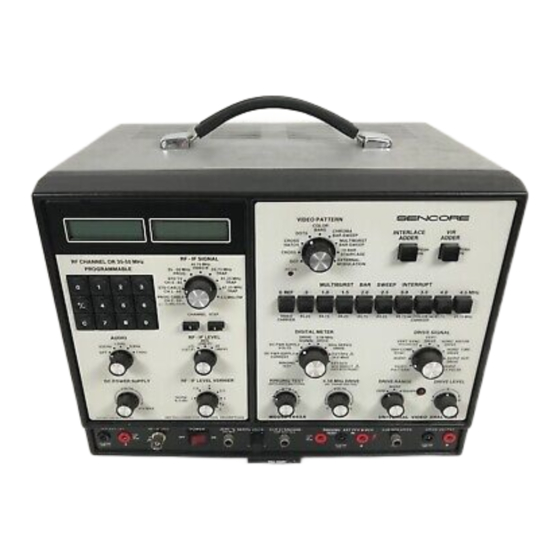
Table of Contents
Advertisement
Quick Links
#178
SE:NCORE:
®
Means Success In Electronic Servicing
tech •.
&lps
Testing Digital TV Tuners
The digital tuners found in today's TVs and
VCRs are more reliable than older
mechani-
cally switched tuners, yet they still fail. When
they
do,
the VA62A Universal Video Analyzer
provides the signals and tests needed to isolate
and correct the
problem.
The VA62A's all-
channel
operation,
with the ability to offset any
channel's frequency, provides dynamic testing
of digital
tuners.
This Tech Tip explains how to relate service
literature to
tuner
symptoms,
and then how to
use the VA62A to isolate
problems.
Understanding Band Switching
Most conventional
(non-digital)
tuners have
only
three tuning
bands.
The low-band VHF tuner
covers channels 2-6, the high-band VHF tuner
covers channels
7-13,
and the UHF tuner
LOUL
osc
fll[Q
covers from channel 14 through the top UHF
channel.
(Older UHF tuners covered through
channel
83,
while newer ones stop at channel
69,
since the FCC has allocated channels 70
through 83 to other
uses.)
Digital tuners often add cable bands to the VHF
and UHF tuner sections. This requires
several
more tuner
sections.
The channel numbers
where bandswitching occurs vary from one
receiver design to the next. Knowing where
bandswitching occurs helps in troubleshooting
suspected tuner
problems.
Channels in
each
band should be tested to confirm that the tuning
system works
correctly.
While it is possible for a tuner to improperly tune
channels in the center of a
band,
the most likely
problem channels are at the upper and
lower
edge of each
band.
These channels require the
tuned stages to be set to their extreme
limits,
making them the most difficult for the automatic
CK
U
--
I H - - -
C
Hl2)
-14,-
-
--"t------------~---
i
""'
.....
ut.TllA
~~
C H . 1 4 -
)I
T - - - -
:~R1;;~===~;~~ ~ ~ 0 - 0 . . . >
o jo-....._
-
--------~::=----t
CATV
'"'
C l t . A A
--
J H - -
-
SU' E i <
..
-
-
HI
- --
~:~
300
C < J - - U l -
-
-
e~~~-{CK.ll --2,7------=t"----------::=-------J
CATY
CK.7
-- l l l - - -
MIO
200
llAHO
CATV
{
<",
l
- m
-
- - -
CK.A-Z
-
1
$)---
-
-1--""'-- - - - - - - - - - - -
-- t
~~!'o-['"'
--1n----
-l-----=""----------I
~~t'
CK.
2
--IOl·---
1
0 o)LL...~""""":_.__.~.__J_~~'-'-~._J,_~~'-'-~'-'
'"
Courtesy Philips
Consumer Electronics
Fig. 1: This tuning
chart from a TV
schematic lets you
determine the num-
ber of tuning bands
and the channels at
each band edge.
circuits to
capture.
You need to know where
bands
switch,
in order to know which channels
need extra
attention.
Service literature usually
shows which channels fall at band
edges,
al-
though some interpretation of the literature
may
be
needed.
Interpreting Service Literature
Fig.1 shows a typical tuning voltage chart found
on a tuner
schematic.
Notice that this chart has
four
curves,
indicating the tuner has four
bands.
Drawing a line from ends of each curve to the left-
hand scale identifies the ends of each
band.
The channels for this particular tuner break out
as follows:
Chart
Channel
Band
Channel Frequency Frequency
I
Bottom
2
101
55.25
I Top
6
129
83.25
II Bottom
A-2
153
109.25
II Top
13
257
211 .25
Ill Bottom
J
263
217.25
Ill Top
RR
449
403.25
IV Bottom
SS
455
409.25
IV Top
125
845
799.25
UHF
Bottom*
14
517
471 .25
UHF Top*
69
847
801.25
*NOTE: Cable band IV and UHF use the same tuner
band.
Fig. 2: The top and bottom channel for each
of the tuning bands represented by the curves
in Fig. 1
Notice that the frequencies listed in the service
literature (3rd column) do not agree with standard
channel assignments (fourth
column).
The
tun-
ing chart references the frequency of the tuner's
local
oscillator,
not the video carrier
frequency.
To convert from the oscillator frequency to the
carrier,
subtract
45.
75
MHz,
which produces the
intermediate frequency
(IF)
after
mixing.
#178
l:ZJtl
Advertisement
Table of Contents














Need help?
Do you have a question about the VA62A and is the answer not in the manual?
Questions and answers